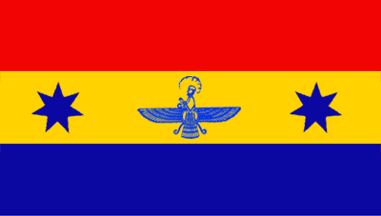After nearly a quarter of a century of bloody Civil War, religious conflict and regional separatism, the newly crowned Shahanshah Dariush VI Behrad entered the 19th century with the support of a shaky alliance of Zoroastrian reformists, Western-influenced Nobles, and opponents of the old Dynasty. With Byzantium and the Crusader Kingdom to the west, the Immortal separatists to the north and further separatists to the east in Islamic Afghanistan, the Persian Empire is united only by the threat of annihilation. Understanding that he must unite the country, or be crushed, Dariush IV ordered the restoration of the Noble Council in direct imitation of the Parliaments of Europe. Though "strictly advisory", the men summoned to council are the Generals, Administrators and the Demagogues of the era - the very men whom he owes his crown to.
The next few years will decide whether these were the last gasps of a dying Empire in a Modern Era, or the coming of the second Sayoshant.

A History of the Modern Zoroastrian Empire
The next few years will decide whether these were the last gasps of a dying Empire in a Modern Era, or the coming of the second Sayoshant.

A History of the Modern Zoroastrian Empire
The Sayoshant (867-1096)
The sources for this period are semi-legendary, the most reliable being Islamic in origin. Though little is known about Vandad I Karen's life, what is known is that under him, and presumably a series of heirs, the Zoroastrian faith successfully pushed back the Sunni forces in Persia Proper. After expanding throughout Iran, Shah Vandad II, Vandad I's great-nephew, declared war on the Abbasid Caliphate - despite being outnumbered 3:2, Vandad II was a military leader and strategist. He won battle after battle against the Caliphate, pushing the boundaries of his Shahdom to the Euphrates River, and even further.
Vandad II was quick to capitalise on this victory. He swiftly restored the High Priesthood of the Zoroastrian faith, elevating the Herbad of Esfahan to the Moabadan-Moabad, the Priest of Priests, claiming that the faith had been restored to it's former glory and that the enemies of the Sacred Fire had been vanquished. The Moabadan-Moabad then declared that Vandad II was the Shah of Shahs, and for having saved the Zoroastrian faithful from Islamic yoke he was almost certainly the Promised One, the Sayoshant. Vandad II quickly made sure that the title of Shahanshah was linked with the divine blood of the Sayoshant, marrying his son to his daughter and declaring the Karenid dynasty to be sacred. This practice was not unknown within the Zoroastrian faith - incestuous marriage was not frowned upon in Zoroastrianism.
The early era of the Persian Empire continued without issue. It expanded into the Caucasus, conquering the Khazars and also expanding into central Asia. Attempted invasions by the Seljuk Turks were repelled - though not easily, as Persian troops were forced to defend tight mountain passes in northern Iran to defeat the Turks. This, however, caused friction with the neighboring Eastern Roman Empire, who, faced with a growing heathen empire growing in it's backyard, appealed to the western Christians for aid...
The Crisis of Succession (1756-1770)
Shahanshah Fath III Karen was stubborn when it came to producing heirs. Though Brother-Sister marriage was still technically allowed for those with the Blood of the Sayoshant, he considered the tradition backwards and refused to consummate his marriage to his eldest sister, Salomeh, which had been arranged by his long reigned Great-Grandfather, Amin I Karen. Though he certainly had a few illegitimate children in court, he produced no true heir. He reined from 1721 to 1756, and despite intense nagging from his council he refused to legitimise any of his bastards, and instead named his nephew, Amin Shirazade, his heir on his deathbed. This was complicated by one very small fact - Amin Shirazade would have been the absolute last choice for Shahanshah for almost every single noble in the Empire.
Amin Shirazade was, according to all contemporary letters and writings about him, a phenomenal bore. He was neither interested in the arts or the sciences, rarely bothered to keep up to date with either international or internal politics, and was not gifted in conversation. That was not to say he was simple, as there is documented evidence that he graduated from the University of Baghdad, but instead that he was simply average. He fostered no personal alliances, and the few friends he had were political nobodies. Consequently, Amin was given a visit from a Spahbod (an Army Chief), along with a few powerful noblemen, a day after Fath III's death - and after a few hours of persuasion Amin agreed to refuse the Shahanshahdom. Amin then promptly left the country with his close family and lived the remainder of his days in Jerusalem.
With the closest thing to a legitimate heir of out the way, the nobility were free to back whomever they felt would benefit them the most. A prominent cadet branch of the Karen family, originating in Birjand, put forward Fath III's cousin, Farvand, as a female heir. However, women could only inherit if it could not be proven there is no closer male heir, and by the time the High Priesthood were convinced the Behradids (Farvand took her father's name as the new dynasty name) had the right to the throne, another pretender arose - Fath Sadrizade Karen, Fath III's second cousin-once-removed. Fath Sadrizade, adopting the name Fath IV, had the support of the high aristocracy, seen as a traditionalist Zoroastrian, a Karenid through-and-through, and someone who would revert the reforms to the Zoroastrian religion of the previous century. Farvand, on the other hand, had the support of the petty nobility and the middle classes, who were long sick of the stagnant Karenid dynasty, who used their "Sacred Blood" as an excuse for favouritism, and had family trees that had long ceased to make any rational linear sense.
Fath IV maneuvered more quickly, and was crowned Shahanshah in January 1857. Farvand promptly went north to appeal to the Immortals - the military order had long since ceased to respond to the Shahanshah in any sense, preferring to rule the steppes autonomously, however were still obligated to defend the Empire if it was under threat. If the Immortals had ignored her as a pretender, the crisis would have ended there without blood. This was not the case. The Immortals had Farvand Behradid crowned in opposition to Fath IV, and for the next 14 years both sides attempted to collect foreign influence among both European and Asian powers, preparing for the day war did break out...
The War of Succession (1770 -1799)
The "Official" start of the war began in April 1770. Fath IV, emboldened by his then substantial reign, repealed the Marriage Law, which banned close incestuous marriage. This was a move to provoke Behradid supporters, which it certainly did - protest broke out in the religious capital of Esfahan, sparking violence between Orthodox and Reformist groups. Fath IV sent in the army to quell the tensions, and in doing so managed to capture and execute anti-Orthodox leaders throughout Persia. His reign, which was growing more and more tyrannical, began to lose support in the nobility, who were having second thoughts about their Shahanshah. It moreover provoked an Islamic revolution in the eastern provinces, who were also staunchly anti-Orthodox, leading to the re-establishment of the Sunni Caliphate in Afghanistan in 1773.
Farvand, believing this was her chance, ordered for the Immortals to seize the northern half of Persia. The Battle of Khiva in 1774 was won easily by the Behradids, who crushed Fath IV's northern armies and captured Spahbod Abbas Karen. Abbas was a notable troublemaker under Fath IV, and his post in Khiva was half a punishment for speaking out against the regime, and pledged his support to Farvand the moment the battle was lost. Fath IV himself was succumbing to madness by now, and made ludicrous demands of his remaining generals - nobles that supported him became nervous, and seeing the military supremacy of Farvand and the immortals they began secret plans to make peace. This was ultimately thwarted by Fath IV's death in 1783, who tripped down a staircase and, suffering from a poorly understood hereditary illness, died of internal bleeding a few days later. His infant son, Dariush V, on the throne, whom was far easier to manipulate by the Regency council. Thus, the war continued.
This was when what was widely seen as an internal conflict began to take an international interest. Farvand had courted British favour since her crowning, and promised trade advantages to the British should they support her claim. The war was also escalating, larger battles were taking place, and though the front line was rarely moving in the mountainous terrain the casualties became higher and higher. Trade became highly limited and neighbouring powers began to suffer from the reduced trade flow from Persia. The Regency Council, trying to gain funds to pay their armies and mercenaries, raised tariffs to take advantage of what little trade came through. This was the final straw for Britain, who in 1790 formally declared war on the Karenids.
The British forces landed on the south coast fairly quickly, leading to the lengthy Siege of Shiraz from 1790 to 1793. Farvand's forces moved south, trapping the remaining Spahbods between the British and the Behradids. Not all was well for Farvand, however, the Immortals, deciding their job was done and taking advantage of the situation at hand, went back home and declared total autonomy from Persia, naming themselves "Cumania". With no spare forces to deal with their treachery, Farvand had no choice but to use her remaining troops to finish off the Karenids.
Dariush V, now a young man in 1793, finally decided the war was lost. Privately agreeing with the British, rather than his nobles or Farvand, he gave up the throne and went in quiet exile to India. Karenid resistance remained in the south for a few years after, rallying around a few candidates, but none truly gaining a foothold or the support of the war-weary Persians. Farvand officially took the throne in 1794, and quickly consildated her power. Amnesties were granted to all but the most fanatic Karenid supports, several trade agreements were signed with the British to ensure that they would not attempt to exert authority over the Empire. Her reign lasted a mere 5 years, and most of it was concerned with repairing the sorry state of the nation and removing what remained of the Karenid loyalists. With her death, her middle aged son Dariush, who served as her chief diplomat, became the new Shahansah.
19th Century Zoroastrian Culture
Unlike the Abrahamic religions that neighbour it, Zoroastrianism upholds that participation in worldly pleasures is not only permitted but sacred. A key tenant is that the human soul, the urvan, was sent to the mortal world to participate in life experiences. The concept of free will and choosing one's fate is, to some, a sacred right - hedonism and decadence is considered the norm in the vast majority of the Zoroastrian nobility. What most of Christian society would abhor or consider taboo is considered a normal weekend in Shiraz; it is almost a sacred duty to partake in all kinds of enjoyments, both mental and physical, and the wealthy were all too happy to partake. The largest impact this has had on Zoroastrian society is an explosion in the arts and philosophical thought - more often than not Persia was ahead of Europe in many artistic movements. Most Persians in prominent positions were expected to have at least a casual understanding of art and poetry, and moreover it was a considerable faux pas to reject earthly pleasures.
This had an unfortunate side effect, however. Firstly, the upper classes bred like rabbits throughout the 17th and 18th centuries - combined with better medicine and lower deaths in childbirth a rapid growth in the nobility occurred. Large dynasties, such as the Karenids or the Samanids, had more legitimate and illegitimate children than they knew what to do with. As many also could trace their lineage to the Sayoshant, they also felt entitled to positions of consequence. Though this benefited the sciences, which had no shortage of educated men attempting to make a name for themselves, the military and administration ended up being filled with ambitious backstabbers. Secondly, corruption was rife wherever it could be gotten away with. Though Zoroastrianism strongly disproves of dishonesty, some see it as a "necessary evil" to allow adherence to earthly pleasures. These issues were the target of the Reformation in the 17th century, which attempted to limit the rapid growth of the nobility with stricter marriage laws and enforce the moral consequences of corruption, but in 1800 these issues were still taking a noticeable toll on the Empire.
A final issue plaguing the Empire since it's inception was the acceptance and even encouragement of marriage between close family. While marriage between cousins was occasionally frowned upon in Western society throughout the period, Brother-Sister, Father-Daughter, even Mother-Son marriages occurred in Zoroastrian culture. It was considered a "Sacred Marriage", Xwedodah, and thus granted some social status to the married couple. As the effects of inbreeding were poorly understood until the 17th century, when Persian natural sciences took an interest in such things, the upper classes were blissfully unaware of why half their offspring were deformed or lunatics. While the practice of marriage between those with one degree of relation were ultimately banned under Fath III in the 1740s, such marriages do still occur by claiming siblings are actually cousins.
The Zoroastrian Empire is also notably tolerant of other faiths. The Mesopotamian rivers, bordering the Christian Kingdoms, became a destination for Muslim and Jewish refugees from the Holy Land. Baghdad became a cultural center due to it's acceptance of foreign cultures, prestigious even in some parts of the western world. Even Christianity is adhered to in some parts of the Empire, with the Nestorian church even receiving some patronage from a minority in the upper classes. Naturally, Zoroastrianism is the religion of choice for those looking to climb social ladders, but it is not unheard of for Muslim, Christian or even Jewish practitioners to gain a noble status.
Yet one of the most significant change in the 19th century to Zoroastrian culture was the emergence of a nouveau-riche that occurred throughout Persia. Though wealthy merchants were not uncommon beforehand, with the breaking of the nobility's backs in the War of Succession there was finally elbow room for this class to rise to political and social prominence.
TL;DR - Lots of vicious nobles, rampant hedonism, some religious tolerance, occasional incest. Assume pseudo-Ottoman values substitute anything you're confused about.
Rules and Gameplay
Characters
Whenever you introduce a new character to the game, try to use this format:
Name: Zoroastrian names use the following format: Personal Name, Father's name -zade (or -dohkt if female), Dynasty. Example: Fath Sadrizade Karen.
Date of Birth:
Culture: Major cultures in the Empire are, but not limited to, Persian, Kurdish, Arabic, Turkmen, Azerbaijani and Armenian. Persian is dominant.
Religion: Zoroastrianism is by far the largest and has the most clout, but Islam, Nestorian Christianity and Judaism exist within the nobility. Zoroastrianism is divided into Reformed and Orthodox.
Position: Whilst all are assumed to be nobility, their roles are either Administrative (Satrap), Military (Spahbod), Merchantile (no fancy title for this one) or Spiritual (Moabad).
Bio: Flavour text here!
More than one character per play is allowed for RP, though each player only has one vote in the Noble Council. Characters, depending on their position, run provinces, lead armies, make trade flow, partake in the arts and sciences, or uphold the moral integrity of the Empire. Moreover, the dynasty of your character is also important, Karenids are naturally inclined to stick together, whilst other dynasties are more adaptable.
Characters will also be mentioned in GM Updates, and significant IC posts will be referenced throughout. It's encouraged to give your character a life outside of public affairs and give a glimpse of the personal lives of your characters and their dynasty.
The Royal Council
The Shahanshah's Council is the main body which players communicate with the His Majesty, made up of selected nobles based on a vague set of categories involving wealth, birth and position in the government. The council is "Advisory", however under the reign of Dariush VI it's words are taken far more seriously than previous generations.
Similarly to other games, players can propose laws, resolutions and actions in the council. Unlike other government games, however, such actions do not need to be approved in majority by the whole council, but instead simply need the Shah's approval. That does not mean the Council is powerless, however. Near unanimously supported proposals are forced through, while those with extreme minority support cannot have their own bills forced through.
The Council can, if fate allows it, ask to have it's powers expanded by the Shahanshah. Whether the Empire trends towards aristocratic absolutism or western-style parliament is the player's choice.
Whilst political parties do not exist in Council politics, factions do exist. They are usually focused around a single individual rather than a political ideal, and are generally dynastic in nature.
To make your vote official, make it bold.
More info to come.
Last edited:





